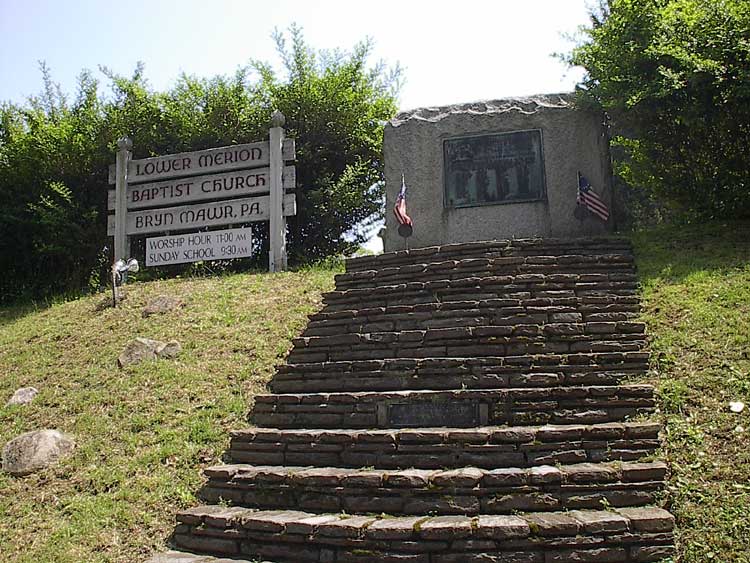Lower Merion Baptist Church was founded in 1808. Its original 19
members worshiped at the Harriton Estate of Charles Thomson where they
were baptized in Mill Creek. It was the first church in the Bryn Mawr
area. In 1809, Thomson donated land from his estate for the erection of
a Baptist Meeting House and starting a cemetery, becoming a regular
worshiper for many years. The Church cornerstone was donated in 1810 by
Charles McClenaghan.
The first pastor was the Reverend Dr. Horatio Gates Jones, who served
for 46 years. The Church opened its cemetery in 1809. Initially, the
Trustee's regulations restricted tombstones to 18 inches height, with
horizontal placement. These restrictions were withdrawn in 1833, so
that most stones are now vertical and of varying heights. Buried in the
cemetery are 16 descendents of William Penn, as well as 35 soldiers of
Revolutionary War, 24 of the War of 1812 and 51 of the Civil War. A
plot map of the burial lots can be found on the Church website and an
alphabetical list of all burials on the Lower Merion Historical Society
website.
Charles Thomson's likeness is represented in the center stained-glass
window contributed in 1887 by George W. Childs, publisher of the
Philadelphia Public Ledger. Other memorial windows were added at that
time, when renovations changed the style of the historic building,
replacing plain glass windows with Gothic style stained glass windows.
Additions to the sanctuary were made in 1859 and 1887, an interior
renovation was made in 1930 and a vestibule added in 1933, given by the
Woodrow Wilson family. This family attended the Church and lived in its
parsonage while Wilson was professor at Bryn Mawr College.

In 1931, the Church provided their corner at New Gulph and Old Gulph
Roads for a Lower Merion Township Revolutionary War Memorial. A
committee of Merion Chapter DAR, led my Mrs. H. A. Arnold and Miss
Margaret B. Harvey, also members of the Church, and the Church pastor,
dedicated this piece of land, believed to contain the buried remains of
unknown Revolutionary War soldiers. The Commonwealth of Pennsylvania
provided a bronze tablet and the DAR donated a large granite tablet.
Lower Merion Township removed a tree and graded the embankment, on
which the DAR erected a stair of 13 steps, one for each of the original
13 Colonies. The Commonwealth seal adorns the tablet and the
inscription reads "Erected by Commonwealth of Pennsylvania and the
Merion Chapter of the Daughters of the American Revolution. This tablet
is in commemoration of the services of Charles Thomson, Secretary of
the Continental Congress, and soldiers who served from Lower Merion
Township in the Revolutionary War. This marker is dedicated in grateful
recognition of their patriotism, valor and fidelity." There are then
listed the 82, then known, soldiers who lived in the Township.
Although this meeting house, built before there was any village,
railroad or college in Bryn Mawr, remained the heart of the Church, the
congregation made missions in several other locations. A chapel and
educational building on Lancaster Avenue were used until shortly before
the property was sold in 1952 to the Suburban Water Company. In 1873,
the Church organized a Sunday School in Merion Square (Gladwyne) and in
1884 erected a chapel at Conshohocken State and Youngs Ford Roads. In
1961, this building was sold to the Gladwyne Boy Scouts. Churches were
also established in Ardmore, Newtown Square and south Bryn Mawr, known
today as Saints Memorial Baptist Church.